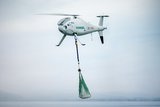Northrop Grumman and US Air Force's Global Hawk Unmanned Aircraft continues round-the-clock reconnaissance in Haiti
The RQ-4 Global Hawk, Northrop Grumman Corporation's premier unmanned reconnaissance aircraft system, continues its persistent watch over Haiti. To date, the Global Hawk has flown six missions, approximately 130 hours, and provided more than 3,600 images of Port-au-Prince and areas damaged by the massive earthquake and ensuing aftershocks that rocked the Caribbean nation earlier this year.
"Thanks to Global Hawk's highly advanced sensors, which are capable of taking hundreds of images in a single mission, we've provided disaster assessments for various agencies to make real-time decisions," said Gen. Bob Otto, commander of the 9th Reconnaissance Wing, Beale Air Force Base, Calif. "The ability to fly 24-hour duration sorties meant the Global Hawk could support hundreds of ad-hoc requests while staying well clear of the relief workers and neighboring airports. Truly, Global Hawk's capabilities have proven invaluable to the worldwide humanitarian efforts in Haiti."
On Jan. 13, a US Air Force Block 10 Global Hawk was diverted by the 12th Reconnaissance Squadron at Beale Air Force Base from its trip en-route to support usual wartime operations in Afghanistan to assist in relief efforts after Haiti's 7.0 magnitude earthquake on Jan. 12. A Global Hawk took off from its main operating base at Beale Air Force Base, flew to Haiti, and provided 12 hours of coverage over the disaster area before landing at Patuxent River Naval Air Station, Md. Subsequent missions were launched from Maryland to provide 14 to 16 hours of persistent watch over Haiti before landing back at Patuxent River.
"Not only has Global Hawk helped determine the extent of damages and usability of Haiti's infrastructure, it has also helped to find and recommend roadways and airfields accessible for delivering emergency supplies and rescuing injured and trapped people," said George Guerra, Northrop Grumman vice president of high-altitude, long-endurance systems. "We are committed to supporting the ongoing relief efforts in Haiti for as long as necessary to help rebuild the lives of those affected."
The Global Hawk team collaborated with other agencies to assist in all aspects of recovery and relief. Officials and analysts from US Southern Command in Miami, the 548th Intelligence, Surveillance and Reconnaissance (ISR) Group from Beale Air Force Base, the 480th ISR Wing from Langley Air Force Base, and the Naval Air Systems Command Broad Area Maritime Surveillance Demonstration program from Patuxent River helped provide critically needed imagery and information.
Capable of flying at altitudes up to 60,000 feet for more than 32 hours at a time at speeds approaching 340 knots, Global Hawk is equipped with an integrated sensor suite, which includes synthetic aperture radar, electro-optical and infrared sensors. Global Hawk has supported previous humanitarian relief efforts, including the southern and northern California wildfires in 2007 and 2008, respectively, as well as Hurricane Ike in 2008.
Source: Northrop Grumman
More from Uncrewed Vehicles
-
Jammer resistant drone designs spark search for countermeasures
The Russia-Ukraine conflict has driven another stage of evolution for drones and the counter measures to defend against them.
-
![L3Harris launches Amorphous software for control of uncrewed platforms]()
L3Harris launches Amorphous software for control of uncrewed platforms
The new Amorphous software is a universal controller that would allow a single operator to control a swarm of “thousands” of uncrewed systems, from drones to underwater platforms.
-
ideaForge unveils new UAVs at Aero India 2025
India UAV supplier ideaForge has launched the Netra 5 and Switch V2 drones at Aero India 2025, boasting of enhanced endurance, AI-driven autonomy and improved operational capabilities.
-
![Shaping the future of defence: What 2025 holds for the global drone market]()
Shaping the future of defence: What 2025 holds for the global drone market
The UAV market is experiencing unprecedented growth, with innovations in technology and battlefield applications driving demand across military sectors. From the battlefields of Ukraine to NATO exercises and beyond, drones are transforming how wars are fought and supported.
-
![Maris-Tech confirms customers signing up for Jupiter Drones codec and AI-powered system]()
Maris-Tech confirms customers signing up for Jupiter Drones codec and AI-powered system
Launched at AUSA in October, the company’s multi-stream video codec is attempting to bring a new lease of life to drone technology through its AI accelerator.
-
![AUSA 2024: Quantum-Systems targets big 2025 with UAS developments]()
AUSA 2024: Quantum-Systems targets big 2025 with UAS developments
Quantum-Systems has been upgrading its UAS family, with new versions of the Vector, Reliant and Twister drones set for release throughout 2025.
























